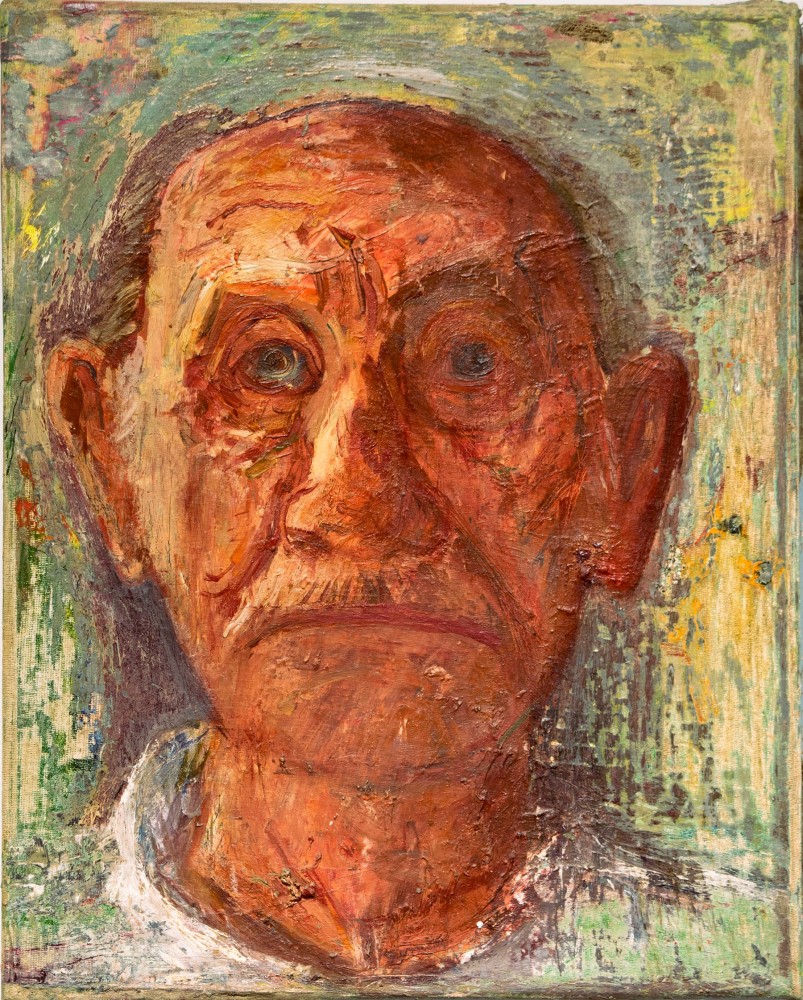
John Lees
Portrait, 1972; 2005
Oil on canvas
20 x 16 inches
JL15481
John Lees’s hallmark obsession with his interior life is legendary. The twenty-seven works on view at Betty Cuningham Gallery are concrete examples of his introspective style; they are ponderous, blisteringly intense, and hyperspecific. While his obsessiveness may fuel a rich interior life, it has clearly come at a cost. He seems to have little time or energy left over to pursue that elusive possession of the comfortably successful artist: recognition.
The works on the first floor of the gallery serve as a primer to his two main obsessions. Lining the wall to the left are multiple paintings of “42nd Street”—a reference to the 1930s American musical film—while on the right are profile drawings of his father, drafted with a Renaissance style, along with a few smaller drawings and a single painting titled Clown in a Frame (2015). His signature painting of jazz legend Lester Young, Polka Dots and Moonbeams (1978; 2001; 2015), hangs at the front.
His works grow even more obsessive as you descend the staircase to the lower gallery. With the exception of a mountainscape, all eleven works either depict Lees’s father or the more recent motif of “42nd Street.” On the left wall, a drawing in ink and graphite, Emil Jannings in The Way of all Flesh (Paramount 1927) (2008) reflects both Lees’s delicate touch and his deep knowledge as a cineaste. Next to it is the winking masterpiece titled In the Park (2008 – 2015), in oil on canvas, depicting Lester Young strolling the greensward, infused with a playful, Hitchcock-like self-portrait of the painter. Completing this trio is another drawing in graphite and ink titled In the Park/Early Morning(2015).
Next, mounted alone on the back wall, is the pièce de résistance, the large oil on canvas painting titled Man Sitting in an Armchair,painted between 2008 and 2015, as the seeming culmination of all the smaller drawings and paintings of his father. The painting is layered, just as time and memory are layered.
By exposing the thickness of memory and its multi-dimensional quality, Lees also exposes the dynamism of his process. His multiple applications of a palette knife and multiple scrapings show not simply the length and breadth of memory, but also its depth, which underscores its persistence. For Lees, time is as important an element of painting as it is for a novelist or memoirist. This painting seems to speak to the viewer clearly and deeply, though in a baritone whisper.
On the wall opposite is a similar culmination of the many “42nd Street” renditions. At first glance,42nd Street (Main Title and Dialogue) (2015) has the primitive energy of folk art, but a closer look shows that it also captures some of the zest of Pop art as well as the sophistication of postmodern appropriation.
Back in the gallery’s office, the particular work Portrait (1972;2005) depicts a recognizable figure: the man in the armchair. Look closely. Hold his stare. Though his face is scored with life’s setbacks and scarred with life’s pains, he is steadfast, dignified, and valiant.